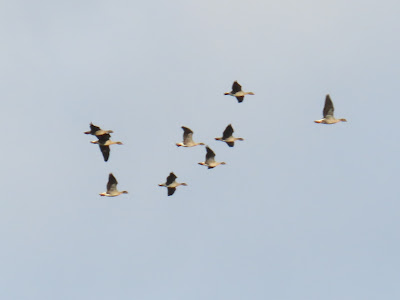
I take a bus to Holderness road by Saltshouse Road, and make my way to Bilton, and then across the fields to Ganstead. There is a pedestrian crossing across the busy A165, but afterwards it's tricky to follow the right of way north of Ganstead, first a narrow path between garden fences, then by a farm as the wooden bridge over a drain is almost totally collapsed. It is not a deep drain and I decide to cross it by balancing on the only remaining beam. It is a sunny day, cold and a bit breezy. A Buzzard rides the wind to a telegraph pole.
Blackbirds at Bilton.
The view towards Bransholme.
A mature tree with a rope swing south of Ganstead.
The path crosses a field with medieval ridge and furrow just south of Ganstead.
Grey Squirrel at Ganstead.
Buzzard.
Most of this route is alongside arable fields, with a few pastures. Fields are low-lying and prone to flooding, the land flat or slightly undulating, less than 5 m OSL. Most fields are bounded by ditches or ditches and hedgerows. The toponym 'Carr' occurs several times: Swine Carr, The Carrs and Turf Carr, indicating waterlogged woods in the area, before widespread drainage started. I reach the Hull to Hornsea rail trail, an abandoned railway line now used as a public right of way and cycle track. As I approach the trail, flocks of Fieldfares, Redwings and Blackbirds explode from the Hawthorns. A local birdwatcher I meet there, Peter, tells me about a Little Owl spot and a local Peregrine.
Fieldfare.
The Hornsea Rail Trail.
Old Swine station, now a private dwelling.
I follow the road onto the small village of Swine, with its spectacular Priory Church,
St Mary's, the only remaining building standing from its old Nunnery (top shot), although there is a protected archaeological site with the remains of moats, fish ponds and buildings nearby. From then onwards, the road only serves as an access road to a few farms, so there is very little traffic. Near Woodhouse farm, I flush a group of Grey Partridge.
Main street at Swine. The Dancing Lane caught my eye.
Rook calling.
One of four Roe Deer.
Yellowhammers. Pairs are dotted along the road between Swine and Benningholme.
A calling Buzzard.
More Roe Deer on a fallow field.
I get to Fairholme double bridge, where three large drains merge: the Monkbridge Stream, the Lambwath Stream and the Kelwell Drain.
Fairholme Double Bridge.
The merged Lambwath and Kelwell drain.
The Monkdyke Stream and the pretty Fairholme House Bridge.
I have some trouble finding the right of way when I realise that it actually is in between two hedges close together, and it's a delightful change of atmosphere, the winter sun filtering across the branches, and the alarming Redwing and Fieldfare overhead.
The lane to Wawne from Fairholme, Common Lane.
Redwing.
Some Pink-footed Geese fly overhead.
I emerge from the enclosed lane, and hear a distant chatter. It's a flock of Linnets singing, a Linnet chorus. A Kestrel hunts nearby. I'm very close to Wawne, the end of today's walk. I cross the Holderness Drain and follow Common Lane to Grange Croft, and wait for Stagecoach 10 to take me back to Hull.
Linnets singing.
An impressive polypody growing on a long-forgotten hanging basket.
Wawne Church.
Today's walk.





























No comments:
Post a Comment